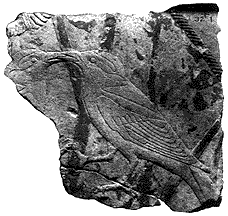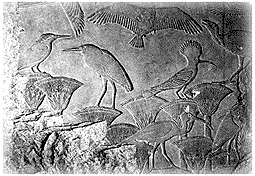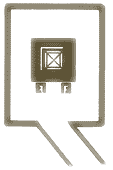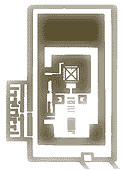 |
|
Westcar Papyrus and the
start of the 5th Dynasty.
The Westcar papyrus states
how the 4th dynasty passed into the 5th (a certain Djedi, a wise
man who may have been a 'magician' or priest, was a member of
the court of Khufu. Djedi would entertain the king with stories
- one of these stories turns into prophecy,
|
 |
This prophetic story
relates how a wife of the High priest of Re at Heliopolis would
give birth to three sons ("born one cubit long.... the covering
of whose limbs were of gold and whose headress was of real lapis
lazuli"), each son would become king.
(The Westcar papyrus
itself was written in the Hyksos period, but the story of Djedi
at the court of Khufu probably originated in the 12th dynasty
- read the full account of this
prophecy).
(Left, statue of Userkaf
found in his sun-temple, above colossal statue of Userkaf found
inside his funerary temple - on the south side of Userkaf's pyramid
(note this has been restored slightly electronically)).
|
Userkaf himself, was
the grandson of Djedefre (son of Khufu) - his mother, Queen Neferhetep,
was Khufu's daughter. Userkaf further strengthened his claim
to the throne by marrying Khentkawes, daughter of Menkaure.
Apart from details given
in the Westcar Papyrus, nothing is known concerning the reign
of Userkaf. However, Userkaf's reign did leave two monuments:
The Pyramid
of Userkaf
('Userkaf
is purest of sites')
Original
Height - 49 m
Length
of Side - 73.5m
|
 |
The Pyramid has suffered
greatly over the years, now barely recognisable as a pyramid
instead looking more like a giant mound of rubble (the site had
been used a convienant quarry for builders of other local projects).
The pyramid was first identified as being that of Userkaf's by
Cecil M. Firth in 1928, it is located at Saqqara along the north-east
wall of the pyramid enclosure of Djoser. Although it's battered
state does not give a good impression of its former grandeur,
enough information is left to although archaeologists to reconstruct
the groundplan of the site:
 |
| A
- Pyramid of Userkaf |
F
- Vestibule |
| B - Entrance |
G
- Saite tomb |
| C
- funerary chapel |
H
- Satellite pyramid |
| D
- Funerary Temple |
I
- Secondary pyramid |
| E
- Courtyard |
J
- Processional Ramp |
The pyramid was originally
encased in fine Tura limestone, the burial chamber also lined
and paved with fine limestone (the sarcophagus was made of basalt
- this was empty when discovered).
The satellite pyramid
(the tomb of Queen Neferhetepe) was similarly ruined - the remains
now contain only a few blocks of limestone which had been the
ceiling of the burial chamber.
|
The funerary temple,
originally surrounded with granite pillars, was decorated with
bas-reliefs and also held a colossal statue of Userkaf (see picture
above)
 |
 Two scenes found
within the funerary temple
Two scenes found
within the funerary temple
|
The Sun -Temple of Userkaf
- 'Stronghold of Re'
Although his pyramid
was built at Saqqara, Userkaf began a new building project at
Abusir - that of the Sun temple, this signifies the with the
beginnings of the Fifth Dynasty - the cult of Re at Heliopolis
takes on new importance. Following the building of this first
solar temple, following members of the dynasty would not also
build their sun-temples at Abusir but also their pyramids (written
sources state that there were six temples built here, but only
four are known). Although the site had extensively quarried for
stone in acient times, when Herbert Ricke excavated in 1955-7,
enough was left for its basic plan to be mapped out. Userkaf's
temple was built in several successive periods (the 1st phase
being the temple being perhaps nothing more than a symbolic mound
surrounded with a wall, 2nd phase a granite obelisk added to
the top of the mound, a building clad in quartzite and granite
replacing the original mound. 3rd phase the enclosure and area
around the obelisks completely rebuilt (it is thought that it
was the later king, Niuserre that added an inner enclosure wall
and chambers of limestone. In the 4th phase a mudbrick altar
was added - the Palermo stone states that two oxen and two geese
were sacrificed daily in this temple.
phases 1,2 and
3 (diagrams not to scale)
Both
queens had their own separate pyramids within their own enclosures.
Iput's pyramid was originally built as a mastaba tomb but was
later altered into a pyramid by Pepi I (her son). The pyramid
had a height of 15.75m - it was built directly over the burial
shaft of the Masataba. Although Iput's burial had been disturbed,
her skeleton was still intact - part of a necklace, a gold bracelet
and 5 canopic jars were also found.
Little
now remains of Khuit's pyramid - its estimated original height
of 20m has now shrunk down to a mere 7m.
|









